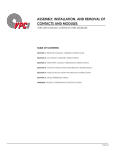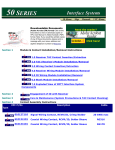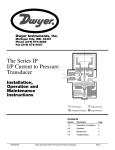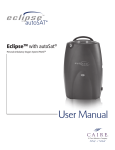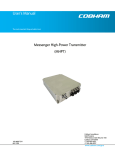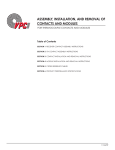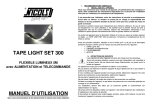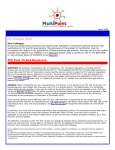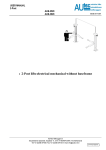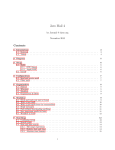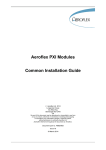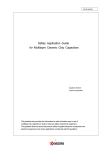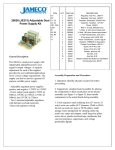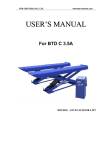Download Click 1.7.pm7.0 - Virginia Panel Corporation
Transcript
CLICK USER’S MANUAL Ver. 1.7 Module & Contact Insertion/Extraction — Section 1 1.0 Receiver Twin Access Contacts (TAC) Insertion/Extraction P/N 610 122 101 (Signal/S-TAC), 610 133 101 (Coaxial/C-TAC, 50 OHM), 610 133 102 (C-TAC, 75 OHM), 610 135 101 (Power/P-TAC) To insert Contact into Module, remove the contact retaining plate from the bottom of the module by unfastening the #2 Flat Head Phillips Screws. Insert contacts into the rear of the module with the stop ring of the contact facing the back of the module. The contacts will automatically “drop” into alignment. Replace the contact retaining plate and secure with two #2 Flat Head Phillips Screws. The contact retaining plate must be removed prior to the extraction of the contacts. To remove the contact retaining plate, unfasten the #2 Flat Head Phillips Screws and remove the contact retaining plate. The contacts are then easily extracted by hand. TAC Module shown with Retaining Cap removed to allow for the insertion of TAC Contacts. (RECEIVER) TAC MODULE STOP RING OF PIN ALWAYS TOWARD RETAINING PLATE CONTACT RETAINING PLATE Insert TAC’s longer end (from stop ring) into module first. Once populated, refasten the retaining plate onto the TAC Module. WARNING: Do Not Depress Contacts with Fingers COMPLETED TAC MODULE 4 P/N: VMCLC200 Ver. 1.7 CLICK USER’S MANUAL Module & Contact Insertion/Extraction — Section 1 2.0 Receiver TAC Module Installation/Removal P/N 510 130 152 (380 pos. Signal Module), 510 130 153 (220/24 pos. Signal/Coaxial Module), 510 130 182 (46 pos. Coaxial or Power Module), 510 130 183 (180/10 pos. Signal/Coaxial 75 OHM Module), 510 130 258 (CLICK 228/12 pos Signal/Coaxial 50 OHM Module) To install Module into Receiver, place two, #2 Socket Head Cap Screws, 1/2" length, in the TAC Receiver Module. Place the Module in the front of the Receiver aligning the locating pins on the module with the appropriate holes in the Receiver Frame, so that the upper and lower module screws touch the mating holes in the Receiver frame (install modules such that the numbers can be read from top to bottom, making them right-side up). Using a 5/64 Allen Hex Wrench, tighten the top screw 1 to 2 full revolutions, while lightly applying pressure against the face of the module. Maintain this pressure while tightening the bottom screw 1 to 2 full revolutions. Repeat this sequence until the module is seated. As the module is being seated, watch to ensure that it does not become cocked at any time as a result of the guide pins not being properly aligned with the Receiver or binding of the pins due to one screw being advanced ahead of the other more than 1 or 2 turns. If this should occur, back the screws off until the module is level and repeat the tightening process. Torque the screw until it is 4 to 5 inch pounds. (NOTE: IT IS IMPORTANT TO ALTERNATE THE TIGHTENING/LOOSENING OF MODULE SCREWS) TAC Receiver Module properly seated in CLICK Receiver Frame. Virginia Panel Corporation INSERT TAC MODULE SUCH THAT THE RETAINING PLATE FACES BACK OF RECEIVER, SCREENED SIDE UP 5 CLICK USER’S MANUAL Ver. 1.7 Module & Contact Insertion/Extraction — Section 1 3.0 Wiring Contact Insertion/Extraction P/N 610 127 110 (Signal Crimp/Solder Contact), 610 127 111 (Signal Wire-Wrap Contact), 610 134 101/102/103/104/105 (Coaxial Contacts), 610 136 101/102 (Power Contacts) To insert Contact into Module, first terminate contact by crimping, soldering, wire-wrapping (see termination instructions in Section 4) or using SMB/SSMB connectors. Insert terminal into module until top of contact is flush with module. When installing Wiring Contacts in the Receiver Wiring Module (P/N 510 130 161, 510 130 162, 510 130 259, 510 130 174, 510 130 181), insert the contacts in from the screened side of the module. When installing Wiring Contacts in the ID Wiring Module (P/N 510 131 138, 510 131 139, 510 131 144, 510 131 145, 150 131 159), insert the contacts from the screened side of the module as well. To remove the Wiring Contacts, place the appropriate Extraction Tool (Signal - P/N 910 110 110, Coaxial/Power - P/N 910 112 112, Coaxial/75 OHM - P/N 910 112 116), over the contact into the counter bore on the mating side of the module. Press into the contact until the retaining ring is released and contact begins to emerge from the rear of the module. Remove the contact by hand. CAUTION TWIST POWER/COAXIAL AND SIGNAL EXTRACTION TOOLS SLIGHTLY TO ENSURE THAT RETAINING CLIP EARS HAVE FULLY COLLAPSED BEFORE APPLYING PRESSURE TO HANDLE TO AVOID DAMAGE TO CONTACTS, ALWAYS ENSURE THAT TOOL IS PERPENDICULAR TO MODULE FACE 6 P/N: VMCLC200 Ver. 1.7 CLICK USER’S MANUAL Module & Contact Insertion/Extraction — Section 1 4.0 Receiver Wiring Module Installation/Removal P/N 510 130 161 (380 pos. Signal Module), 510 130 162 (220/24 pos. Signal/Coaxial Module) 510 130 174 (46 pos. Coaxial or Power Module), 510 130 181 (180/10 pos. Signal/Coaxial 75 OHM Module), 510 130 259 (228/12 pos. Signal/Coaxial (50 OHM) Module) Place the module on the rear of the Receiver aligning the locating pins on the modules with the appropriate holes in the Receiver Frame. Install the modules such that the numbers can be read from top to bottom, making them right side up. Insert the #2 Socket Head Cap Screws, 1/2" length, in the module fastening holes. Using a 5/64 Allen Hex Wrench, tighten the top screw 1 to 2 full revolutions, while lightly applying pressure against the face of the module. Maintain this pressure while tightening the bottom screw 1 to 2 full revolutions. Repeat this sequence until the module is seated. Torque the screw until it is 4 to 5 inch pounds. To remove, loosen the top screw 1 to 2 full revolutions. Loosen bottom screw 1 to 2 full revolutions. Repeat this sequence until the module is separated from the Receiver. (NOTE: IT IS IMPORTANT TO ALTERNATE THE TIGHTENING/LOOSENING OF MODULE SCREWS) SCREENED SIDE OF MODULE Back-side of Receiver with Receiver Wiring Module (P/N 510 130 162) shown Virginia Panel Corporation 7 CLICK USER’S MANUAL Ver. 1.7 Module & Contact Insertion/Extraction — Section 1 5.0 Interface Device (ID) Wiring Module Installation/Removal P/N 510 131 138 (380 pos. Signal Module), 510 131 139 (220/24 pos. Signal/Coaxial Module), 510 131 144 (46 pos. Coaxial or Power Module), 510 131 145 (180/10 pos. Signal/Coaxial 75 OHM Module), 510 131 159 (228/12 pos. Signal/Coaxial (50 OHM) Module) To install Module into ID, place module in the ID with the screening facing downward. Align top of the module with the designated top of the ID and the locating pins on the module with the appropriate holes in the ID. The modules should be installed such that the numbers can be read from top to bottom. Insert the #2 Socket Head Cap Screws, 1/2" length, in the module fastening holes. Using a 5/64 Allen Hex Wrench, tighten the top screw 1 to 2 full revolutions, while pushing lightly against the face of the module. Maintain this pressure while tightening the bottom screw 1 to 2 full revolutions. Repeat this sequence until the module is seated. Torque the screw until it is 4 to 5 inch pounds. ID WIRING MODULE To remove, loosen the screws until the module is CLICK ID separated from the ID. Loosen cable clamp and push wire bundle towards module until module is free of ID. SCREENED SIDE OF MODULE ID Module (P/N 510 131 139) being properly inserted into CLICK ID 8 P/N: VMCLC200 Ver. 1.7 CLICK USER’S MANUAL Module & Contact Insertion/Extraction — Section 1 6.0 Exploded View of CLICK Interface System Components TAC MODULES P/N 510 510 510 510 510 130 130 130 130 130 152 153 182 183 258 RECEIVER DESCRIPTION 380 POS SIGNAL 220/24 POS SIG?PWR OR C (SHOWN) 46 POS PWR OR CX 180/10 POS SIG/CX (75 OHM) 228/12 POS SIG/CX (50 OHM) P/N 310 117 115 DESCRIPTION CLICK RECEIVER FRAME ID WIRING MODULES P/N 510 131 138 510 131 139 510 131 144* 510 131 145* 510 131 159 DESCRIPTION 380 POS SIGNAL 220/24 POS SIG?PWR OR CX (SHOWN) 46 POS PWR OR CX 180/10 POS SIG/CX (75 OHM) 228/12 POS SIG/CX (50 OHM) RECEIVER WIRING MODULES INTERFACE DEVICE (ID) P/N 410 115 127 DESCRIPTION CLICK ID P/N 510 510 510 510 510 130 130 130 130 130 161 162 174* 181* 259 DESCRIPTION 380 POS SIGNAL 220/24 POS SIG?PWR OR CX (SHOWN) 46 POS PWR OR CX 180/10 POS SIG/CX (75 OHM) 228/12 POS SIG/CX (50 OHM) *NOTE: When using SMBs in CLICK Connector, use clamp-type SMBs for flexible cable, cannot use crimp-type SMB in CLICK. Consult factory for more information. Virginia Panel Corporation 9 CLICK USER’S MANUAL Ver. 1.7 Engagement of ID with Receiver — Section 2 ! Caution ! TO AVOID ELECTRICAL SHOCK All power supplies for the system should be properly disconnected prior to handling.** Caution should always be used during engagement, making sure that all foreign objects are removed from the system. Serious damage can be caused to the TAC contacts if they are not protected when the system is disengaged. It is recommended that either the ID or Receiver Protective Cover is engaged to the Receiver at all times. Listed below are the required steps to be taken prior to the engagement of the ID and Receiver. •Prior to engaging an ID with the Receiver for the first time, the user may find it to be good practice to check that all the Modules (ID and Receiver) have been installed properly. This would involve the inspection of the module ends - ensuring the even height of all module ends relative to one another. While checking this, the user should verify the positioning of the modules themselves. Verify module placement using screening location. It is crucial for all modules to be installed properly. •Improper installation will cause damage to the Modules, and possibly to the ID and/or Receiver. All ID Modules have to match the Receiver Modules. This means that upon engagement, an ID Module will mate with its respective Receiver Module (Signal ID to mate with Signal Receiver, etc.) •The ID, upon being inspected, is now ready for engagement with the Receiver. The Receiver should be checked one last time for any foreign objects that may hinder the engagement. To attach the ID to the Receiver, place ID dogs into Receiver slots, apply pressure to the ID cable clamp area until the latch catches in the Receiver. Rotate lock so latch cannot be operated. ID DOGS •When not in use, snap rubber protective cover over ID. SLOTS **It is strongly recommended to ground or divert electrical power when system is not in use. VPC recommends wiring two signal pins through a relay, thereby creating a circuit for the relay to be activated when the CLICK is engaged. 10 P/N: VMCLC200 Ver. 1.7 CLICK USER’S MANUAL Engagement of ID with Receiver — Section 2 Keying Pins: The CLICK Connector is equipped with keying positions to ensure wired IDs are mated to the matching wired Receiver. There are three exclusive keying positions, accomplished with three keying holes located on the Receiver frame and three keying holes located on the ID. The user can configure using a combination of the 3 (each) Plugs and Pins in the 6 holes. ID ROTATING LOCK KEYING PINS KEYING PLUGS INSERTION DIRECTION RECEIVER •The keying pins are screwed into the threaded keying holes from the outside of the ID. •The tapered plastic plugs are inserted in the keying holes on the Receiver that do not have a keying pin or pins in the corresponding holes on the ID. Firmly press in the plugs until they are flush with the Receiver Frame, with the tapered end being inserted into the hole from the inside of the Receiver. Virginia Panel Corporation 11 CLICK USER’S MANUAL Ver. 1.7 Care and Maintenance — Section 3 1.0 System Precautions In the event of complications, such as improper alignment of Modules or ID, a trained technician should be notified immediately to avoid any damage to the system. This should also apply to any difficulties that may be experienced during the engagement. The CLICK is designed to be maintenance free. However, there are few precautions to take in order to prolong the life of the system. NOTE: Cover, Bushing and Cable Clamp screws to be tightened no more than 21 inch pounds max! CAUTION Serious damage can be caused to the TAC contacts if they are not protected when the system is disengaged. It is recommended that either the ID or the Receiver Protective Cover is engaged to the Receiver at all times. Care should be taken when utilizing TAC contacts in dirty or dusty environments. Mating surfaces of TAC contacts should be kept clean of dust and debris to ensure performance within stated specifications. Connector receivers should be mounted in the vertical position to minimize potential for dust and debris to accumulate on the contact surface areas. If dust and debris should accumulate on the contact surface areas, use the TAC Contact Cleaning Procedures below. 2.0 TAC™ Contact Cleaning Procedures TAC Contacts may require periodic cleaning during the life of the product due to the usage cycle imposed, as well as the environmental conditions to which it is subjected. If unacceptable resistance readings occur, the contacts should be cleaned using the following procedure: •Spray contacts with filtered air or inert gas to remove any loose particle contamination. •Clean contact mating surfaces using isopropyl alcohol and a soft bristle brush. (Do not pour alcohol directly onto contacts, apply to brush). •Respray contacts with filtered air or inert gas to dry alcohol and remove any residual lint, dust, etc... By following this procedure for both the TAC contacts and the mating surface contacts or PWB pads, the user will avoid any performance problems that could arise due to contamination. CAUTION Virginia Panel Corporation PROHIBITS the use of any type of contact lubricant/cleaner to be used other than the procedure listed above. Contact cleaners that contain lubricants may leave residues that will degrade the electrical performance of the TAC Contacts. updated 8/15/02 12 P/N: VMCLC200 Ver. 1.7 CLICK USER’S MANUAL Contact Assembly Instructions — Section 4 Virginia Panel Corporation has been providing the ATE industry with quality parts and accessories for over 30 years. To ensure that this same level of quality is maintained, VPC Interface System Users must follow certain guidelines for all components used in operating, servicing and adjusting their system. Assembly Instruction Sheets are supplied with the Interface Systems, available directly from VPC or found in this manual. The user is advised to strictly follow the Assembly Instruction Sheets in order to prolong the use and maintain the quality of the system. Power Wiring Contact (P/N 610 136 101/102) Assembly Instructions have been omitted as termination is accomplished by soldering only. Assembly Instruction Sheets are available for the following contacts: VPC P/Ns D es c r i p t i o n 610 127 110 Sign al Wir in g Co n t act , RCVR/I D, Cr im p/So lder 610 134 101 Co ax ial Wir in g Co n t act , RCVR/I D,So lder Sleev e RG316 12 610 134 101 Co ax ial Wir in g Co n t act , RCVR/I D, So lder Sleev e RG178 13 Virginia Panel Corporation Cab le Ty p e P ag e 11 13 CLICK USER’S MANUAL Ver. 1.7 Contact Assembly Instructions — Section 4 Signal Terminal Assembly P/N 610 127 110 Set up crimp tool P/N 910 101 103 (Fig. A) by loosening the latch locking screw (counter-clockwise, until turning stops). Remove any previously used crimp contact locator. Insert the open end of crimp contact locator P/N 910 104 133 into crimp tool contact locator retainer. Slide the retaining latch toward contact locator until contact is securely locked into place. The contact locator may have to be twisted to allow latch to retain contact locator. Tighten latch locking screw. Using the table below, adjust the crimp tool setting by pulling adjusting knob and turning it at the same time (clockwise increases, counter-clockwise decreases setting) until the desired setting is achieved on the microcrimp indicator. Fig. A Wi re Gauge St rip Lengt h + . 05/ -0. 0 Crimp. Max . Crimp Min. 20 .25 .037 .033 10 22 .19 .033 .029 10 Pullout Forc e (lb. ) 24 .19 .029 .025 8 26 .19 .024 .021 4 2-24 .25 .043 .041 8 2-26 .25 .041 .037 4 Using the table above, determine the strip length according to wire gauge. Strip wire. Fully insert stripped wire into contact P/N 610 127 110 (Fig. B). With the crimp tool in the open position, insert the prepared contact and wire through the indenter opening. While keeping the wire fully inserted into the contact, squeeze the handles of the crimp tool until a positive stop is reached. Tool will release and return into fully “open” position. Remove crimped contact and wire. .047 DIA. .70 .065 DIA. Fig. B NOTE: Observe precision ratchet action by opening and closing tool fully several times. Note that tool cannot be opened without completing cycle. Never attempt to disassemble tool. Never tighten or loosen stop nuts on back of tool. updated 3/14/02 14 P/N: VMCLC200 Ver. 1.7 CLICK USER’S MANUAL Contact Assembly Instructions — Section 4 Coaxial Terminal Assembly P/N 610 134 101 — RG316 PARTS REQUIRED: •Solder Kit for Mini Coax includes holding fixture and adapter (P/N 910 121 162) or Adapter (for those who already own a holding fixture) (P/N 910 121 163) •Steinel Heat Gun with Reflector (P/N 910 121 160) INSTRUCTIONS: 1. Prepare the coaxial cable to the dimensions shown (Fig. A). 2. Straighten the center conductor making sure the stranded center conductor is twisted into its original lay. 3. Pretin stranded center conductor with Sn63 solder per QQ-S-571. Use RMA flux per MIL-F-14256 (Alpha #611 or equivalent). 4. Make sure the shield braid is trimmed evenly and no loose strands are extending out across the exposed dielectric or cable jacket. 5. Smooth the braid ends flat against the cable dielectric. 6. Slip the contact over the end of the prepared cable, and carefully push the contact onto the cable until it stops. Rotating the contact slightly during cable insertion will help prevent the braid from catching. 7. Inspect for proper insertion (Fig. B). The center conductor must be visible through one of the forward inspection windows. The distance from the rear of the contact outer body to the cable jacket insulation should be .065±.015. 8. Install the adapter onto the holding fixture (Fig. C). Insert a contact in the adapter and set up the dimensions as shown in Figure C. 9. Insert the contact/cable assembly into the adapter. Clamp the cable in the holding fixture. The cable must remain fully inserted in the contact and the contact must be fully inserted in the adapter (for the adapter to act as a heat sink). The cable must be straight between the contact and the cable clamp. 10. Attach the appropriate reflector to the heating tool (see separate Heat Gun instruction sheet included with tool for tool operation and precaution). 11. Using the holding fixture, position the contact in the heating tool reflector, with the forward inspection window centered in the reflector. Continue heating until the small solder preform in the forward inspection window has melted and flowed. The large solder preform in the rear inspection window should have melted and flowed by this time; if it has not, direct hot air at the rear inspection window until it does. 12. If contact is UNDERHEATED, there will be visible remnants of the original shapes of the solder preforms. An underheated contact must be reheated. If contact is OVERHEATED, solder will wick away from the joint areas, leaving no solder fillets. An overheated contact must be removed and a new contact installed. 13. After the contact has cooled for at least 10 seconds, remove the contact and cable from the holding fixture. 14. Inspect the completed termination for correct assembly. The cable shield must extend into the contact at least as far as the front edge of the rear inspection windows. The center conductor must be visible through one of the forward inspection windows. Fig. A Fig. B Fig. C Virginia Panel Corporation 15 CLICK USER’S MANUAL Ver. 1.7 Contact Assembly Instructions — Section 4 Coaxial Terminal Assembly P/N 610 134 101 — RG178 PARTS REQUIRED: •Solder Kit for Mini Coax includes holding fixture and adapter (P/N 910 121 162) or Adapter (for those who already own a holding fixture) (P/N 910 121 163) •Steinel Heat Gun with Reflector (P/N 910 121 160) INSTRUCTIONS: 1. Prepare the coaxial cable to the dimensions shown (Fig. A). 2. Straighten the center conductor making sure the stranded center conductor is twisted into its original lay. 3. Pretin stranded center conductor with Sn63 solder per QQ-S-571. Use RMA flux per MIL-F-14256 (Alpha #611 or equivalent). 4. Fold the center conductor back on itself as shown (Fig. B). 5. Make sure the shield braid is trimmed evenly and no loose strands are extending out across the exposed dielectric or cable jacket. 6. Smooth the braid ends flat against the cable jacket. 7. Slip the contact over the end of the prepared cable, and carefully push the contact onto the cable until it stops. Rotating the contact slightly during cable insertion will help prevent the braid from catching. 8. Inspect for proper insertion (Fig. C). The center conductor must be visible through one of the forward inspection windows. The distance from the rear of the contact outer body to the cable jacket insulation should be .015±.015. 9. Install the adapter onto the holding fixture (Fig. D). Insert a contact in the adapter and set up the dimensions as shown in Figure D. 10. Insert the contact/cable assembly into the adapter. Clamp the cable in the holding fixture. The cable must remain fully inserted in the contact and the contact must be fully inserted in the adapter (for the adapter to act as a heat sink). The cable must be straight between the contact and the cable clamp. 11. Attach the appropriate reflector to the heating tool (see separate Heat Gun instruction sheet included with tool for tool operation and precaution). 12. Using the holding fixture, position the contact in the heating tool reflector, with the forward inspection window centered in the reflector. Continue heating until the small solder preform in the forward inspection window has melted and flowed. The large solder preform in the rear inspection window should have melted and flowed by this time; if it has not, direct hot air at the rear inspection window until it does. 13. If contact is UNDERHEATED, there will be visible remnants of the original shapes of the solder preforms. An underheated contact must be reheated. If contact is OVERHEATED, solder will wick away from the joint areas, leaving no solder fillets. An overheated contact must be removed and a new contact installed. 14. After the contact has cooled for at least 10 seconds, remove the contact and cable from the holding fixture. 15. Inspect the completed termination for correct assembly. The cable shield must extend into the contact at least as far as the front edge of the rear inspection windows. The center conductor must be visible through one of the forward inspection windows. Fig. A Fig, B Fig. C Fig. D 16 P/N: VMCLC200 Ver. 1.7 CLICK USER’S MANUAL Cable Bundle Wire Information — Section 5 A formula to calculate the maximum number of wires recommended for a cable bundle is shown below. Using this formula, the table below shows a sampling of the maximum number of wires that will fit in the oblong bushing; for example the oblong bushing will hold a maximum of 683 Signal (20 AWG) wires OR 202 Coaxial (RG316) wires. 1.25 Formula to calculate approximate number of wires in a cable bundle: N = (D/d - 1)2(.907) N =N umber of Wires D=*Inside Diameter of Converted O blong Bushing d=O utside Diameter of Wire .54 Oblong Bushing Opening Size = 1.59”* diameter - 3.927=C Wire Type Outside Diameter Number of Wires 20 AWG Signal - Teflon .056 683 10 AWG Power - PVF .160 72 RG316 Coaxial _ 50 OHM .100 202 NOTE: Addition of shrink tubing or braid will reduce maximum number of wires through bushing. * Oblong Opening Circumference Converted to Simple Diameter Virginia Panel Corporation 17 CLICK USER’S MANUAL Ver. 1.7 TAC™/PCB Information — Section 6 1.0 Pad Recommendations for TAC™/PCB Development All contact pads are to be gold plated per MIL-G-45204, Type1, Grade C, .000120 min. thick over Nickel plating per QQ-N-290, Class 2, .000150 min. thick. Board material is left to the user as the material used will depend upon variables such as antici pated environmental conditions (temperature, humidity, chemical resistance, etc.) and electrical parameters (voltage breakdown, dielectric constant and others). Specific circuitry may also limit the desired flexing. VPC supplies the force per contact exerted upon the board and the contact array dimensions. Once the operational contact array is determined, we recommend that the complete environmental, electrical and mechanical requirements be given to a professional board designer for design review. Deflection can be calculated using the following equation: Deflection = D “l” “w” “t” *Modules of Elasticity = E Board width = w Board thickness = t Moment of a board: Deflection: wt3 I= 12 Board length = l Fl3 D= in inches 48 EI Forces = F Signal TAC contact = 2 ounces max. Coaxial (50 and 75 OHM) TAC contact = 7 ounces max. Power Tac contact + 20 ounces max. Deflection at no time should exceed .020 *Modules of elasticity can be obtained from the board manufacturer. 18 P/N: VMCLC200 Ver. 1.7 CLICK USER’S MANUAL TAC™/PCB Information — Section 6 2.0 TAC™/PCB Mounting Specifications for CLICK Receiver Frame Figure 1.0. Depicts TAC™/PCB Mounting Holes on CLICK Receiver Back Side Virginia Panel Corporation 19 CLICK USER’S MANUAL Ver. 1.7 Trouble-Shooting and Solutions — Section 7 Receiver and ID fail to close: • Locking mechanism on the latch is in the locked position. • Foreign objects may have fallen into the Receiver mechanism. • The Modules and/or Contacts may have been improperly installed. No continuity through contact(s): • The ID and Receiver Wiring modules may be interchanged, resulting in miswiring because of the reversed screening. • TAC contacts have been inserted backwards which will prevent the Receiver Wiring Module from being attached to the back of the Receiver frame. • A contact may have been damaged. Visually check all ID, Receiver TAC and Wiring Contacts for damage to potentially isolate damaged pin prior to checking for continuity with a multimeter. Precautionary Notes — Section 8 The foremost precautionary step that needs to be taken is to protect the Interface System from damage caused by people (bumping into the Receiver/ID assembly with a box, chair or electronic equipment for example). To prevent this, VPC recommends engaging either the ID or Receiver Protective Cover to the Receiver at all times. 20 P/N: VMCLC200 Ver. 1.7 CLICK USER’S MANUAL Part Number and Description Listing — Section 9 RECEIVER 310 117 115 310 113 354 CLICK Receiver Frame CLICK Universal Protective Cover ID 310 113 354 410 115 127 CLICK Universal Protective Cover CLICK ID Frame and Housing VERTICAL HINGED MOUNTING FRAME 310 113 310 310 113 311 310 113 312 Rack Mounting Panel for CLICK Receiver/0.25” thick aluminum gold chromated 6.96” x 19” Vert. Hinged Mntg. w/pos for 5 CLICKs including cover plates for unused slots, 8U VXI chassis Vert. Hinged Mntg. Frame, 9U, CLICK Receiver TAC MODULES (FOR TAC CONTACTS, RECEIVER SIDE ONLY) 510 130 152 380 Position Signal Receiver TAC Module 510 130 153 220 Position Signal & 24 Position Coaxial or Power Receiver TAC Module 510 130 183 180 Position Signal & 10 Position Coaxial (75 OHM) Receiver TAC Module 510 130 258 TAC Mod. (RCVR) w/228/12 sig/coax pos. RECEIVER WIRING MODULES (FOR WIRING CONTACTS) 510 130 161 510 130 162 510 130 174 510 130 181 510 130 259 380 Position Signal Receiver Wiring Module 220 Position Signal & 24 Position Coaxial or Power Receiver Wiring Module 46 Position Coaxial (50 OHM) or Power Receiver Wiring Module 180 Position Signal & 10 Position Coaxial (75 OHM) Receiver Wiring Module RCVR Wiring Mod. w/228 sig/12 coax ID WIRING MODULES (FOR WIRING CONTACTS) 510 131 138 380 Position Signal ID Wiring Module 510 131 139 220 Position Signal & 24 Positon Coaxial or Power ID Wiring Module 510 131 144 46 Position Coaxial (50 OHM) or Power ID Wiring Module 510 131 145 180 Position Signal & 10 Position Coaxial (75 OHM) ID Wiring Module 510 131 159 ID Wiring Mod. w/228/12 sig/coax pos RECEIVER TAC™/PCB INTERFACE 510 130 214 TAC/PCB Interface (RCVR), Signal, with two 96 pin DIN Connectors 510 130 225 TAC/PCB Interface (RCVR), Signal, with three 50 pin DIN Connectors 510 130 226 TAC/PCB Interface (RCVR), Signal, with three 64 pin DIN Connectors 510 130 231 TAC/PCB Interface (RCVR), Signal, with six 34 pin DIN Connectors 510 130 246 TAC/PCB Interface (RCVR), with 380 Signal positions for user configuration 510 130 252 TAC/PCB Interface (RCVR), Signal, 380 positions, staked with unshrouded strip headers that can be mass terminated to AMP ModuTM connectors or wire wrapped 510 130 218 TAC/PCB Interface (RCVR), with two 96 pin DIN Connectors and positions for 12 Coaxial/Power Wiring Contacts TAC/PCB Interface (RCVR), with two 50 pin DIN Connectors and positions for 12 Coaxial/Power Wiring Contacts TAC/PCB Interface (RCVR), with four 34 pin DIN Connectors and positions for 12 Coaxial/Power Wiring Contacts TAC/PCB Interface (RCVR), with 228 Signal positions and 12 Coaxial/Power positions for user configuration 510 130 235 510 130 236 510 130 242 Virginia Panel Corporation con’t on page 22 21 CLICK USER’S MANUAL Ver. 1.7 Part Number and Description Listing — Section 9 (con’t) ID TAC™/PCB INTERFACE 510 131 168 TAC/PCB Interface (ID), Signal, with two 96 pin DIN Connectors 510 131 170 TAC/PCB Interface (ID), with 380 Signal positions for user configuration 510 131 171 AC/PCB Interface (ID), Signal, 380 positions, staked with unshrouded strip headers that can be mass terminated to AMP ModuTM connectors or wire wrapped TAC CONTACTS (FOR RECEIVER SIDE ONLY) 610 122 101 610 133 101 610 133 102 610 135 101 Signal TAC (S-TAC) Coaxial TAC (C-TAC), 50 OHM Coaxial TAC (C-TAC), 75 OHM Power TAC (P-TAC) WIRING CONTACTS (FOR RECEIVER & ID WIRING MODULES) 610 127 110 610 127 111 610 134 101 610 134 102 610 134 103 610 134 104 610 134 105 610 136 101 610 136 102 Signal Wiring Contact, crimp or solder Signal Wiring Contact, wire-wrap Coaxial Wiring Contact, Solder Sleeve, RG316 or RG178 Coaxial Wiring Contact, for SMB (75 OHM) Coaxial Wiring Contact, for SMB (50 OHM) Coaxial Wiring Contact, for .24 snap-on connector (75 OHM) Coaxial Wiring Contact, for SSMB (50 OHM) Power Wiring Contact, 10 AWG Power Wiring Contact, 18 AWG PATCHCORDS P/N 737 737 737 737 737 737 737 737 737 737 737 737 737 737 737 737 737 737 737 737 737 737 737 737 737 737 737 737 737 737 737 737 737 737 737 22 101 101 101 101 101 102 102 102 102 102 102 102 102 102 102 103 103 103 103 103 103 103 103 103 103 104 104 104 104 104 105 105 105 105 105 101 103 105 106 110 101 103 104 105 106 102 107 108 109 110 101 102 103 104 105 106 107 108 109 110 101 102 103 104 105 101 103 104 105 106 Description Used in Module ID/RCVR Signal Wiring Patchcord, 24 AWG, 36” (uses contact 610 127 110) ID/RCVR Signal Wiring Patchcord, 24 AWG, 12” ID/RCVR Signal Wiring Patchcord, 24 AWG, 48” ID/RCVR Signal Wiring Patchcord, 24 AWG, 72” ID/RCVR Signal Wiring Patchcord, 24 AWG, 24” ID/RCVR Power Wiring Patchcord, 12 AWG, 36” (uses contact 610136101) ID/RCVR Power Wiring Patchcord, 12 AWG, 12” ID/RCVR Power Wiring Patchcord, 12 AWG, 24” ID/RCVR Power Wiring Patchcord, 12 AWG, 48” ID/RCVR Power Wiring Patchcord, 12 AWG, 72” ID/RCVR Power Wiring patchcord, 18 AWG, 36” (uses contact 610136102) ID/RCVR Power Wiring patchcord, 18 AWG, 12” ID/RCVR Power Wiring patchcord, 18 AWG, 24” ID/RCVR Power Wiring patchcord, 18 AWG, 48” ID/RCVR Power Wiring patchcord, 18 AWG, 72” *RCVR Power Wiring Patchcord, 12 AWG, 36” for TAC/PCB (uses contact 610136103) *RCVR Power Wiring patchcord, 18 AWG, 36” for TAC/PCB (uses contact 610136104) *RCVR Power Wiring Patchcord, 12 AWG, 12” for TAC/PCB *RCVR Power Wiring Patchcord, 12 AWG, 24” for TAC/PCB *RCVR Power Wiring Patchcord, 12 AWG, 48” for TAC/PCB *RCVR Power Wiring Patchcord, 12 AWG, 72” for TAC/PCB *RCVR Power Wiring patchcord, 18 AWG, 12” for TAC/PCB *RCVR Power Wiring patchcord, 18 AWG, 24” for TAC/PCB *RCVR Power Wiring patchcord, 18 AWG, 48” for TAC/PCB *RCVR Power Wiring patchcord, 18 AWG, 72” for TAC/PCB ID/RCVR Coaxial Patchcord, RG316, 36” (uses contact 610 134 101) ID/RCVR Coaxial Patchcord, RG316, 12” (uses contact 610 134 101) ID/RCVR Coaxial Patchcord, RG316, 24” (uses contact 610 134 101) ID/RCVR Coaxial Patchcord, RG316, 48” (uses contact 610 134 101) ID/RCVR Coaxial Patchcord, RG316, 72” (uses contact 610 134 101) *RCVR Coaxial Patchcord, RG316, 36” for TAC/PCB (uses contact 610134107) *RCVR Coaxial Patchcord, RG316, 12” for TAC/PCB *RCVR Coaxial Patchcord, RG316, 24” for TAC/PCB *RCVR Coaxial Patchcord, RG316, 48” for TAC/PCB *RCVR Coaxial Patchcord, RG316, 72” for TAC/PCB 510 130 161/162/181 “ “ “ “ “ “ “ “ “ “ “ “ 510 130 162/174 510 131 139/144/159 “ “ “ “ “ “ “ “ “ 510 130 162/174 510 131 139/144/159 “ “ “ “ “ “ “ “ “ 510 130 162/174 510 131 139/144 510 131 159 “ “ “ “ “ “ P/N: VMCLC200 Ver. 1.7 CLICK USER’S MANUAL Cross Reference Table — Section 10 TOOLS • • • • • • • 610 136 102 • • • • 610 136 101 • • • • • • • • • • • • • • • • • • • • • • • • • • 3 8 0 S IG 510 130 152 2 2 0 /2 4 S IG /C X 510 130 153 46 CX or PW R 510 130 182* 1 8 0 /1 0 S IG /C X 510 130 183* 2 2 8 /1 2 S IG /C X 510 130 258 3 8 0 S IG 510 130 161 2 2 0 /2 4 /S IG /C X 510 130 162 46 CX or PW R 510 130 174* 1 8 0 /1 0 S IG /C X 510 130 181* 2 2 8 /1 2 S IG /C X 510 130 259 3 8 0 S IG 510 131 138 2 2 0 /2 4 S IG /C X 510 131 139 46 CX or PW R 510 131 144* 1 8 0 /1 0 S IG /C X 510 131 145* 2 2 8 /1 2 S IG /C X 510 131 159 S IG C R IM P 910 101 103 S IG L O C A T O R D IE 910 104 133 S IG E X T R A C T . 910 110 110 C X /P W R E X T R A C T . 910 112 112 CO AX EXTRACT. 910 112 116 SOLDER GUN 910 121 160 S O L D E R K IT 910 121 162 ADA PTER FOR RAYCHEM 910 121 163 • • • S T E IN E L H E A T G U N 910 121 167 • • • • • • • 610 134 102 • • 610 134 101 610 135 101 610 133 102 • • 610 134 103 IT A W IR IN G M ODULES 610 127 111 R C V R W IR IN G M ODULES SURFA CE CONTACTS 610 127 110 TAC CONTA CTS TAC M ODULES PART NUMBER 610 133 101 D E S C R IP T IO N 610 122 101 TAC CONTACTS • • • • • • • • • • • • • • • *NOTE: When using SMBs in CLICK Connector, use clamp-type SMB for flexible cable, cannot use crimp-type SMB in CLICK. Virginia Panel Corporation 23 CLICK USER’S MANUAL Ver. 1.7 Interface Devices — Section 11 CLICK Interface Devices The CLICK Interface Device (ID) is a two-piece frame and housing, made of clear chromated aluminum and glass reinforced nylon with the integration of steel mesh for EMI protection. With one module position, the ID can hold up to 380 Signal connections or our Signal/Coaxial (or Power) combination modules. The CLICK ID is secured to the CLICK Receiver Frame with an integrated locking latch located on the ID. The latch includes a safety lock to ensure continuous connection when the interface is engaged. The two-piece ID design allows for easier assembly, inspection, and maintenance of the wired assembly. An ID Protective Cover, made of rubber, is available to protect the contacts when the ID is not in use. P/N Description 410 115 127 Interface Device (ID) with one Wiring Module position and 1 cable opening with sliding removable cover 310 113 354 Protective Cover for ID and/or Receiver (made of rubber) CLICK ID Universal Protective Cover 24 CLICK RECEIVER Universal Protective Cover P/N: VMCLC200 Ver. 1.7 CLICK USER’S MANUAL Mechanical Mounting Information — Section 12 This drawing is supplied for use by customers who are creating their own mounting panel. 1.28 1.70 .64 .85 .10 Ø .156 THRU TYP. 3 PLCS. A .34 1.22 .24 4.78 5.46 5.27 .57 4.84 5.27 .22 SEE DETAIL - A 1.14 Ø .136 THRU .28 TYP. 3 PLCS. .XX = ±.01 .XXX = ±.005 .16 R. TYP. 4 PLCS. 1.14 RECOMMENDED MOUNTING PANEL CUT-OUT NOTE: See page 26 for detail of A Virginia Panel Corporation 25 CLICK USER’S MANUAL Ver. 1.7 Mechanical Mounting Information (con’t)— Section 12 .09 Ø .136 x .14 DP. .09 WIDE x .08 DEEP .25 .047 DETAIL A LANYARD CHAIN MOUNTING PROVISIONS TYP. 2 PLCS. 26 P/N: VMCLC200























